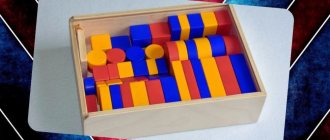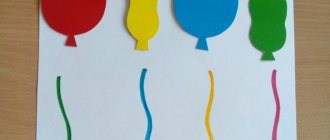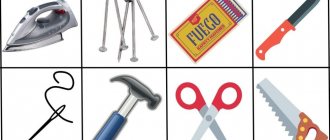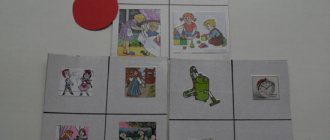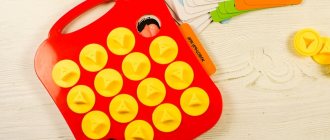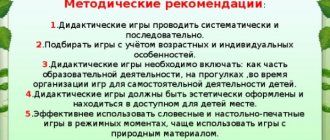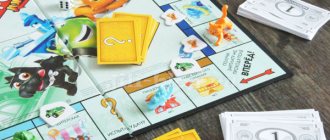Didactic games to develop children's ideas about the color of an object
Target:
- teach to distinguish and name the primary and tint colors of an object; learn to group objects by color;
- develop the ability to analyze, compare and classify.
“Find objects of the same color”
The teacher hands out cards to the children with various images of red, blue, yellow, and green on them. Having determined what color the image on the card is, children come to the table and select figures of a given color and name the color.
“Name the color of the object”
The teacher offers to determine the color of the toy, vegetables, etc.
"Arrange objects by color"
The teacher lays out a didactic set for free play (mosaics, cubes) and encourages the children to name the colors. After this, the children organize the material by color.
"Balloons"
The child is offered a card with a picture of multi-colored strings and a set of circles - balls. You need to “tie” the balls to threads of a suitable color.
Fun Train
The child is offered a card with a picture of a train. A reference card with a picture of a color is placed in the train. The child selects figures of the same color and “seats” them in the trailers.
"Find a tea pair"
The teacher hands out colorful tea cups to the children. There are saucers of matching colors on the tables. Children are asked to find a tea pair - match the color of the cup and saucer.
“Where did Snow White go wrong?”
The teacher arranges tea pairs by color and at the same time makes a mistake and says: “Guests should come to Snow White. She was in a hurry and made a mistake when arranging the tea pairs. Help Snow White arrange the tea utensils by color correctly.”
"The cars are going home"
Children have cards with pictures of multi-colored cars. On the table there are cards with pictures of garages of different colors. The teacher invites the child to find his own garage for each car.
"The car got lost"
The teacher arranges all the cards in pairs, but makes a mistake and invites the child to find for himself which car “drove” into the wrong garage - a garage of a different color.
"For repairs"
The teacher puts all the cars in a row and then removes one. The child must remember which color car is missing.
"Colors"
Option 1.
Select 3 game elements so that 2 of them form a common pair. Invite your child to combine matching elements into one card. At the same time, he must name the color of the pencil shown. Invite your child to then independently assemble the remaining elements into cards.
Option2.
All halves of cards with images of objects are first placed face up in the center of the table, then turned over. Elements with the image of pencils are divided equally between the players. The right to move first is determined by drawing lots or counting. The player who has the right to move takes one of the elements from the table, names what color the item is depicted in, and keeps it if he has the second element of the card with the image of a pencil. The test is the Puzzle lock, which is different for each pair of elements. If there is no suitable half, the element is mixed with those remaining on the table, and the next player gets the right to move. The one who collects his cards first wins.
"Settled home"
(didactic game “Big - Small”)
Place the cards face up in front of your child.
Tell a fairy tale, for example this one.
In one fairy-tale country, all objects of the same color became such strong friends with each other that they decided to live on the same street in a house of the same color. And in order for brothers and sisters - big and small - to live on the same floor, they need to be immediately connected in pairs.
Invite your child to take turns building houses whose pictures on the cards are the same color as the roof. The result will be the following houses: red - 5-story; brown - 3-storey; yellow - 3-story; blue - 2-story; green 2-storey.
When the houses are built, ask the child to count how many floors are in the red house, how many in the green, how many in the blue, etc., named, and show the corresponding numbers.
Ask the child who lives or what is located, for example, on the second floor of a green house or on a brown one, etc. Ask the child to show the highest and lowest floor, to find houses that are the same in height. Let him tell you how many floors there are and what color the roof is.
"Colorful glades"
The child is offered a playing field - a clearing, divided into multi-colored squares and silhouette images of toys, flowers of different colors. In the clearing, you can place objects of the same color on the corresponding squares.
“What did the artist paint incorrectly?”
The teacher offers the children fruits and vegetables that the artist has painted. Children must find what the artist painted incorrectly and name the correct color of the object.
"Assemble the train by color"
(didactic game “Locomotive for Animals”)
On the table there are cards with images of 6 multi-colored trains and carriage cards with images of insects, fish, birds, and a house. And wild animals. The teacher suggests matching the train with carriages with passengers of the same color and placing them in a row.
Didactic games with geometric figures of Dienesh:
- “Find all the shapes like this one” (by color)
- “Find a figure not like this one” (by color)
Informational resources:
1. Z.A. Mikhailova, E.N. Ioffe “Mathematics from 3 to 7”, St. Petersburg, Detstvo-Press, 2001.
2. Z.A. Mikhailova, I.N. Cheplashkina, “Mathematics is interesting”, St. Petersburg, Detstvo-Press, 2004.
3. D. Alhaus, E. Doum “Color, shape, quantity”, Moscow, Education, 1984
4. B.P. Nikitin “Steps of creativity or educational games”, Moscow, Education, 1991.
Municipal budgetary preschool educational institution kindergarten No. 7 of the city of Konakovo
Early childhood educator
MBDOU kindergarten No. 7
Konakovo Ismailova Dinara Shamuradovna.
Games for the development of sensory abilities of children of primary preschool age (1st junior group)
In my opinion, the sensory development of children is an amazing source of enriching children's vocabulary, developing children's interest in a diverse world, and improving children's thinking and other mental processes.
In life, a child encounters a variety of shapes, colors and other properties of objects.
To familiarize younger preschoolers with the properties of objects (color, shape, size), I widely use games with didactic materials (wooden nesting dolls, inserts, etc.) when working with children: for example, when introducing children to a wooden nesting doll, the teacher helps children identify and name the size of the inserts , didactic games with building materials enrich children's play, help them get acquainted with the shape of objects, their color.Children of the 3rd year of life also receive certain sensory knowledge when conducting outdoor games, during which several sensory development tasks are simultaneously solved.
The purpose of these games is to develop children’s sensory abilities (ideas about color, shape, size). Didactic games for color recognition
Game “Rolling colored balls”
Purpose: to distinguish and name primary colors, to develop coordination of hand movements.
Material: collars of 4 colors (red, blue, yellow, green) and balls of the same colors (3 balls of each color).
Progress of the game: children sit on chairs in a semicircle, the teacher is at the children's table in front of them. The teacher brings 4 colored gates, shows them to the children, asks what they are
colors, and puts them in a row in front of the children. Calling the children one by one, he offers to take a ball of his choice from the box. Asks: “Natasha, please tell me what color
your ball? “Red!” “That’s right, take him through the red gate. Take it
green ball. No, it's not a green ball, it's blue. Take green. Give him a ride
through the green gate. Now take the blue ball, that's right, roll it
through the blue gate. Thus, the teacher calls several more people. Game “Placement of fungi of two colors in the holes of tables of the corresponding
color”
Purpose: to consolidate the ability to group homogeneous objects by color, correlate by
different colors of objects. Material: 8-10 two-color tables with mushrooms (used sharply
different color combinations: red, blue, yellow, green.
Progress of the game: the teacher demonstrates a table painted red and blue. Shows and explains that part of the table is one color, and the other part is another color.
Then he shows red and blue mushrooms and explains that part of the table and some of the mushrooms are the same color.
So, having “planted” a red fungus, the teacher emphasizes that the fungus is “hidden” and is not visible. Next, he places a blue mushroom on a part of a table painted blue (this fungus is also “hidden”, it is not visible.) The teacher invites children to the table one by one and invites each to place two mushrooms of different colors on a part of the table of the same color. After explanation and demonstration, the teacher distributes individual material to the children to complete the task independently. Game: Laying out the mosaic “Houses and Flags” (pair placement of color elements)
Purpose: to draw children’s attention to the color properties of objects, showing that color
is a sign of different objects and can be used to designate them.
Material: boxes with a mosaic of hexagonal elements. In every box
4 yellow and 4 red mosaic elements were selected.
Progress of the game: the teacher, showing the children an element of the yellow mosaic, says what’s wrong
there will be houses; showing a red mosaic element, says that this color will be
checkboxes. Then he randomly places a house on the panel, and a flag above the house. Invites one of the children to come to his table, first find a house and
place it on the panel and then check the box. The teacher invites other children to check whether this or that mosaic element has been found correctly.
Then he invites the rest of the children to his table one by one and offers them the same task. Thus, the teacher finds out how each of the children understood the task
The teacher distributes individual material and ensures that the children complete the task correctly. During the work, he draws the children's attention to the correct selection of mosaic elements by color.
Individual guidance consists of guiding questions addressed to children:
“Do all your houses have flags?” Individual, junior or unprepared
Children need to learn to coordinate the movements of the small muscles of the hand. In this case, the teacher takes the child’s hand with his hand and helps him place the elements
mosaics in the holes of the panel
Game: “Balloons”
Purpose: to promote the formation of color concepts in children. Teach
correlate the colors of dissimilar objects.
Material: A strip of cardboard (30/12cm), on which threads of primary colors and
4 multi-colored cardboard mugs - “balloons” - their color matches the color
thread Progress of the game: the teacher shows the children a cardboard strip on which multi-colored threads are drawn. Invites the children to look at the balloons: “Today we are with you
Let's play with balloons. Each of you has a cardboard strip on the table. Look at it and tell me what you see on it. That's right, multi-colored threads. Now look at the balls, they are also multi-colored, like the strings. For each
The ball on the strip of cardboard has its own thread. For each thread you need to pick up a balloon of the same color and “tie the balloon to the string”: “tie” a red balloon to the red thread, a yellow one to the yellow thread, a blue one to the blue thread, and so pick up and
tie all the balls. Watch me do it. The teacher attaches balloons of the corresponding colors to several threads. Explains to children
that these balls are chosen correctly and can be “tied” to threads. Then he shows the balls that are incorrectly selected by color - he attaches, for example, a yellow ball to the green thread, etc. Explains to children how to tie these balloons
This is not possible because they are the wrong color.
Then the children complete this task independently. If children find it difficult
to perform it correctly, the teacher first selects and “ties” two balls on their strip, and offers to find and “tie” the remaining balls
on one's own. Didactic games for distinguishing the size of objects
Game “Stringing large and small beads.”
Goal: to teach children to alternate objects by size.
Material: for each child, eight wooden beads of two sizes of the same color and shape (the diameter of a large bead is 2 cm, a small one is 1 cm), thin cords or thick threads with ends waxed or pre-dipped in glue.
Progress of the game: the teacher shows the children a beautiful doll and explains that she came to visit them and brought something in a basket.
The doll greets the children, the teacher invites the children to also greet the doll. He places the doll on the table and, taking the box out of the basket, shows the children that there are large and small beads and thread there. The doll asks to make beautiful beads for her. An adult takes first a large, then a small bead and strings them on a thread one after the other. Moving from one child to another, the teacher teaches each child how to string beads. Then the teacher tells the children that the doll has brought a lot more beads and gives each of the children materials to complete the task independently. The teacher closely monitors the activities of the students. It helps some children thread a thread through the hole of the beads, while others remind them to alternate beads: first the big one, then the small one, like this. Game “Big and Small Dolls”
Purpose: to distinguish and name objects by size.
Material: dolls, table, chair, large dishes and the same items - small.
Progress of the game: children sit on chairs in a semicircle, the teacher is opposite, behind the children's
table The teacher places a large doll table and chair on the table on the right and
sits a large doll, and on the left - small furniture and sits a small doll. After
This is addressed to the children: “This is a big doll, and this is a small one. Big doll sitting
on a large chair near a large table. The big doll's name is Masha, and the little one's
doll Katya. “Why did they sit down at the table, Sasha? It's probably time for them to have breakfast.
Ask Masha and Katya, did they wash their hands? They say that they washed their hands.
We'll tie napkins for them and feed them. Nina, come to me (shows two
plates - large and small.) Which plate will we feed Masha from? And Katya?
That's right, Masha is big, we will feed her from a large plate, put
there is a big plate in front of her, and Katya is small, put a small one in front of her
a plate. Then the teacher hands out spoons (large and small) to the children and asks
Give the big doll a large spoon, and the small doll a small spoon.
Game "Let's assemble a turret."
Goal: to teach children to assemble a tower, focusing on the model and arranging the rings
in decreasing order.
Material: turret - sample and turrets for each child (turret consists of 5 rings). Progress of the game: the teacher hands out turrets to the children and says: “Let’s look at them together
turret: “There are a lot of rings on the rod, let’s remove them. This is the smallest ring
bigger, it’s even bigger, even bigger and the biggest ring.” Then the teacher
assembles the turret: “First you need to put the largest ring on the rod,
then smaller, even smaller..." After this, the children themselves disassemble and assemble their
turrets. Children gradually find the next largest ring. Educator
watches how the children assemble the turret, reminds them that they must always choose the largest ring from the remaining ones and string it onto the rod. In case of difficulty or
mistakes, children are asked to place the selected ring on the sample to
match the turret rings by size. Game "Fruit picking".
Goal: to develop children’s eye when choosing objects of a certain size based on a model.
.
Material: apples - samples (cut out of cardboard in three sizes - large, smaller,
small; three baskets - large, smaller, small; tree with
suspended cardboard apples of the same size as the samples
(8-10 apples of each size) Progress of the game: the teacher shows the children a tree with apples, baskets, and says that small apples should be collected in a small basket, medium ones - in a medium one
basket, and large ones - in a large basket. Calls three children at the same time,
He gives everyone a sample apple and invites them to “pick” one of the same apples.
from a tree. If the apples are “picked” correctly, the teacher asks to put them in
matching baskets. Then a new group of children completes the task. If all
The apples are collected and placed in baskets, but the children show interest in the game, the apples are hung again, and the game continues.
Didactic games for distinguishing the shape of objects Game “Touch and guess what I gave you .”
Goal: identify by touch and name familiar objects by shape. Material: small objects familiar to children are used (number of objects
corresponds to the number of children - ball, cube, brick, reel,
pencil and others). Progress of the game: 5-6 children sit in a semicircle on chairs, the teacher offers the children
put your hands behind your back, shows a bag of small toys and say: “Now
I’ll put something in each person’s hand from the bag. You don't look, but touch and find out
what did I give you? Addresses the children one by one: “Natasha, what do you have in your hands?
Don’t look, just tell me.” Natasha calls. “Now show me.” That's right, you have a ball,
put it in a bag."
So he interviews each child in turn. Game “What is in the bag”
Purpose of the game: to consolidate children’s knowledge about shape, to practice the correct ratio
several objects with the same geometric pattern.
Material: set of geometric shapes (circle, square, triangle, oval), bag
with objects of different shapes: berries, fruits, vegetables (round and oval
shapes), square and triangular buttons), wooden balls,
eggs, jars, balls, acorns, cones; small flags
(quadrangular and triangular in shape.) Progress of the game: geometric shapes are laid out on the edge of the table. Children sitting
in a semicircle, the bag is with the teacher. Children take turns taking out objects
from the bag, name them, determine their shape. In case of difficulty, the teacher
helps to correlate an object with a geometric figure: “This is an egg, it
oval in shape." Places the egg next to a geometric figure - an oval. Gradually
children place all the objects on the table next to a certain figure. At
playing the game again, you can change the set of items in the bag, increase
or reduce the number of items.
A game.
"Stringing beads of different shapes." Goal: to teach children to alternate objects by shape
.
Material: six round and square wooden beads of the same color
and sizes for each child; the diameter of the round bead is 2 cm,
the side of the square bead is 2 cm, thick threads for stringing.
Progress of the game: a visiting doll or other character brings educational material in a basket. After the traditional knock on the door, mutual greetings, and introduction to the guest, the teacher draws the children’s attention to what lies in
basket. The doll asks the children to make decorations for the other dolls: beads. The teacher shows the children beads and says that they are different in shape:
round and square. Having prepared a couple of beads for stringing, the teacher
determines the order of stringing the beads: first round, then square.
Then he invites to his table one of the most prepared
children, suggests choosing two beads from the box (round and square) and stringing them. The attention of all the guys is fixed on the fact that they are on the thread
beads are put on alternately: round, square, round. Gradually, the teacher approaches each child with his material and offers to select a couple of beads
of different shapes and string them in a certain order: round bead, square.
The teacher invites the children to touch each bead on the string with their hand, saying:
"Round, square, round."
After individual training and finding out the capabilities of each of the kids, the teacher, together with the doll, gives the children material for completing the task independently.
During independent work, the teacher periodically gives verbal instructions.
one, provides direct assistance to other children in selecting beads and
performing actions. The teacher, laying out a string of beads, together with each
the baby checks the progress of his actions: “Round bead, square, round again
and again square.” The adult removes the incorrectly strung beads and
Helps the child complete the task correctly.
At the end of the game, the teacher collects beads from all the children and, together with the kids, shows the doll how many beautiful beads the children have made. Children put on
decorations for dolls. The dolls thank the children. Game: Geometric Lotto.
Purpose: to teach children to compare the shape of the depicted object with geometric ones
shapes and select objects according to geometric patterns.
Material: 5 cards depicting geometric shapes (circle, square, triangle, rectangle, oval), 5 cards each depicting objects of different shapes. Progress of the game: the teacher reviews the material with the children. Children call
figures and objects. Then, according to the instructions of the teacher, they select cards with images of objects of the desired shape for their geometric samples. The teacher helps
children correctly name the shape of objects (round, square, rectangular,
oval, triangular). Five children take part in the game. The one who wins
will quickly match all the cards to the geometric pattern. Didactic game for the development of sensory abilities of preschool children (1st junior group).
Early childhood educator at MBDOU kindergarten No. 7 in the city of Konakovo Ismailova Dinara Shamuradovna. "Funny Pockets" Goal.
To consolidate knowledge of the concepts “big”, “small”, “many-little” and primary colors.
Material.
Funny pockets, teddy bears, large and small; a set of colored pencils.
Progress of the game. Educator.
Children, do you like to play? I love to play too. Look what I brought you, “Fun pockets?” Look how many pockets, they are all different colors!
Dasha, which pocket did you like? What color is it? Masha, what kind of corman do you like? What color is it?
Let's play! Do you want to see, Gosha, what's in my red pocket? (Gosha takes out a small bear.) What kind of bear is this? (Small.) Savva, maybe you'll find something in the blue pocket? (Savva takes out a big bear.) What kind of bear is this? (Big.) The bears want to play with you. A moment of rest.
The bear crawled out of the den and looked around at the threshold (turns left and right). He stretched out of sleep (pull-ups - arms up). Spring has come to us again! To quickly gain strength. The bear turned its head (rotating its head), leaned back and forth (leaning forward and backward). Here he is walking through the forest. The bear is looking for roots and rotten stumps. They contain edible larvae - Vitamins for the bear (tilts: touch your left foot with your right hand, then vice versa). Finally the bear had eaten and sat down on a log (children sit down). Educator.
While we were playing, one bear put something in his green pocket!
Do you want to see what’s there, Anya? (The child takes out colored pencils.) How many pencils did the bear bring? (A lot.) Now Anya will share her find with you and gives each of you one pencil. How many pencils does Anya have now? (None.) Let’s give the pencils to the owner - the bear! How many pencils will each of you give? (One.) How many does the bear have? now pencils? (A lot.) How many do you have? (None.) Now let’s show the bear what colors we know. Kiril, find a toy the same color as this pocket. (Red.) (This is how the colors of all the pockets are played out.) Note speech development classes Topic: What kind of pets and their babies live in our yard? . Goal:
To develop a caring attitude towards pets.
Objectives:
Learn to name domestic animals and their babies.
Distinguish between the concept one and many. To develop word formation skills for nouns denoting baby animals. Nurture children to have a good relationship with animals and show a desire to take care of them. Problem.
From the understanding of the children in my group, we can conclude that only a small part of the children know how to relate animals and their cubs.
Hello
, guys. We have pets in our yard, help me, please
,
what animals live in the yard? (Shows a picture of a cow, recites the poem “Cow”).
There goes a cow, long horns. Where was the cow? I went to the meadows. The caravan approached her house. She began to moo: Mu, Mu, Mu! How does a cow moo?
Children: moo, moo, moo. Vos.Where did the cow go? Children. To the meadows. Q. What were you doing in the meadow? D. Was eating grass Q. What is the name of a cow’s baby? D. Calf. Q. How does he moo? D. Gently, mu-mu-mu! B. One is a calf, and many are calves. D. Say, calf, calves.
Vos. Guys, listen to the riddle.
Who barks in the yard and guards the house? A stranger without an owner is not allowed into the house. Who is it?
D. Dog (shows a picture of a dog). Q. The dog has a small cub. His name is puppy. How does a dog bark? D. Woof-woof-woof. B. One puppy, and many puppies. (show pictures). Vos draws the children's attention to the toy dog, look, a puppy has come to us and wants to play with you. A game .
"Shaggy Dog." Here sits a shaggy dog with his nose buried in his paws.
Quietly, peacefully he sits, either dozing or sleeping. Let's go up to him, wake him up, and see what happens. The children touch the dog, it catches up with them (the game is repeated). Q. Guys, tell me, what does a cat call her baby? D. Meow-meow-meow. Q. And who came running to us? D. Kitten. Q. Fluffy little kitten. How does he meow? D. meow-meow-meow. (gently). V. A cat’s mother has one kitten , but many kittens. Children pronounce kittens (show pictures of kittens). V. Well done guys, you helped me a lot. For this I will give you this game “Pets and Their Cubs” and show you how to play it.
